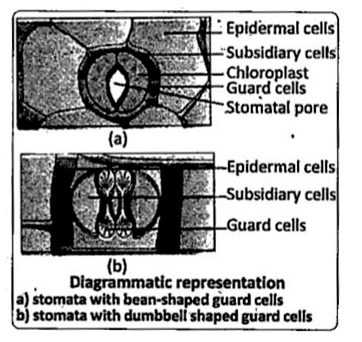Define transpiration. Explain the structure and mechanism of "opening and closing of stomata. Solution in Telugu
Transpiration is defined as the loss of water in the form of vapour from the living tissues of aerial parts of the plants. Structure of Stomata: Each stoma is composed of two bean shaped cells known as guard cells. In grasses, the guard cells are dumb bell shaped. The outer walls of guard cells Guard thin and inner walls are thickened. The guard cells posses chloro plasts and regulate the opening and closing of stómata. Sometimes, a few.epidermal cells in the vicinity of the guard cells become specialised in their - shape and size and are known as subsidiary cells. The stomatal aperture, guard cells and the surrounding subsidiary cells are together,called stomatal .t apparatus.

Opening and closing of stomata : The stoma is the turgor operated valve in the epidermis.
1). The immediate cause of opening or closing of the stomata is a change in the turgidity of the guard cells.es
2) The inner wall of each guard cell towards the pore or stomatal, aperture.iş thick and elastic. ?
3) When turgidity increases within the two guard cells flanking each stomatal aperture or pore, the thin outer walls bulge out and force the inner walls into a crescent shape.
4) The opening of the stoma is also aided by the orientation of the microfibrils in the cell walls of the guard cells.
5) Cellulose microfibrils are oriented radially-rather than longitudinally, making it easier for the stoma to open..
6) When the guard cells lose turgor due to water loss the elastic . innerwalls regain their original shape, the guard cells becomes flaccid and the stoma closes.
Levitt proposed k+ pumip theory to explain the mechanism of opening and closing of photoactive stomata.
Opening of stomata:
1) According to this theory accumulation of Ktjons into the guard cells from the subsidiary cells occurs in the presence of light.
2) This coupled with effux of protons leads to increase in pH of the guard cells.
3) Accumulation of K+ ions into the guard cells is associated with passive influx of Cl− ions thereby decreasing the water potential of the guard cells.
4) Water, thereby enters the guard cells making them turgid.
5) As the outer walls are thin and elastic, the guard cells expand outwardly, leaving a minute pore at the centre open.
Closing of stomata :
1) At night, in the absence of light, the K+ and Cl− . jons move out of the guard cells due to which the water potential of guard cells increases and water starts, moving out of them leading to closure of stomata.
2) Under water stress conditions, abscisic acid (ABA) a natural anti-transpirant drives the K+ ions out of guard-cells making them close.
3) in Succulent plants, the water potential gradient established due to accumulation or organic acids at night makes the guard cells become turgid, hence stomata opens at night.

Stomatal opening Stomatal closing Stomatal opening and closing : Broken arrows indicate passive movement and continuous arrow indicates active movement.
Topper's Solved these Questions
Similar Questions
Write short notes on facilitated diffusion.
05:20View SolutionWhat are the important events and end products of light, reactions?
06:24View SolutionDescribe the structure of the heart of man with the help of neat labelled diagram.
03:30View SolutionWhat causes the opening and closing of guard cells of stomata during transpiration?
05:32View SolutionWhat causes the opening and closing of guard cells of stomata during transpiration?
02:58View Solutionपर्णरंध्रों (stomata ) के खुलने तथा बंद होने की क्रियाविधि का वर्णन कीजिए।
04:06View Solutionवाष्पोतसर्जन को परिभाषित कीजिए । यह कितने प्रकार का होता है ? नामांकित चित्र की सहायता से रंध्र के खुलने एवं बंद होने की क्रिया को दर्शाइए ।
04:47View SolutionWhat causes the opening and closing of guard cells of stomata during transpiration?
05:43View Solutionवनों का महत्व लिखिए।
02:45View SolutionWhat causes the opening and closing of guard cells of stomata during transpiration?
04:05View SolutionWhat causes the opening and closing of guard cells of stomata during transpiration?
06:12View SolutionDescribe mechanism of opening and closing of stomata.
01:31:14View SolutionWho explained the mechanism of opening and closing of stomata.
54:19View SolutionBriefly mention the mechanism of opening and closing of stomata.
01:16:43View SolutionTransportation | | Structure OF stomata | | mechanism OF opeing and closing OF stomata
05:13View Solutionmechanism OF opening and closing OF stomata (different theories).factors affecting opening & closing OF stomata
04:22View Solution

